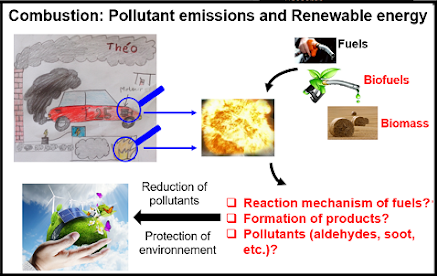
Luc Sy Tran
Research
Research interests:
- Combustion chemistry of oxygenated biomass-derived fuels. Influence of these fuels on the formation of toxic products and ultrafine soot nanoparticles.
- Reduction of pollutant emissions and their chemical risks. Development of clean fuels and cleaner combustion technologies with alternative fuels.
The research of Luc-Sy TRAN has been focused on combustion processes with the purpose of solving two essential problems for the future, energy demand and environmental protection, both of which are strongly related in this case since better combustion implies an energy gain and a limitation of pollution. He has pursued studies directed to understanding combustion chemistry and developing combustion kinetic models, especially for advanced oxygenated fuels.





2023-2027: PEPR “OXY3C”: Carbon capture by eco-efficient oxycombustion processes. French Government in the framework of the decarbonization of the industry to achieve carbon neutrality by 2050. 8 partners: CORIA (porteur), IFPEN (porteur), PC2A, EM2C, LRGP, LGRE, IMFT, MSME. [Role: Scientific leader for “soot kinetics” WP]
2021-2023: I-SITE “BIOFUEL-SOOT”: Combustion of BIOFUELS: contribution to identification of unknown formation mechanism of small SOOT particles. Funded by I-SITE Université Lille Nord-Europe. [Role: principal investigator]
2023: Exploration Japon 2023: Combine strengths to explore the combustion chemistry of new biofuels to produce clean energy. Collaboration with National Institute of Advanced Industrial Science and Technology(Japan). Funded by Ambassade de France au Japon. [Role: principal investigator]
2022-2023: PHC ALLIANCE: “high-performance computing simulations to study the interaction between soot particles with OPAHs”. Collaboration with School of Engineering (London South Bank University). Funded by: In France: MEAE, MESR. In UK: British Council, Department for Business, Energy and Industrial Strategy.
2022: IRePSE 2022 : Identification of OPAHs using comprehensive 2D-GC. Collaboration with LCT Ghent Belgium. Funded by IRePSE. [Role: principal investigator]
2021-2024: ANR “OFELIE”: Oxygenated FuELs impact on spark Ignition engine Emissions. 5 partners: IFPEN (porteur), PC2A, LRGP, PSA, Renault. Funded by ANR. [Role: Participant and supervisor for the thesis of Doha KDOUH]
2021-2027: CPER “ECRIN”: Environnement Climat – Recherche et Innovation. Financé dans le cadre du Contrat Plan État Région (CPER) avec une contribution de l’Europe (FEDER). 34 partenaires dont 25 laboratoires de recherche de la région Hauts-de-France. Coordinateurs: Hervé Delbarre, Coralie Schoemaecker, Pascal Touzet. [Role: Participant to WP1: Impact sur le vivant des changements environnementaux liés au transport, à l’industrie et à la ville]
2015-2020: CPER "CLIMIBIO": Changement climatique Dynamique de l'atmosphère Impacts sur la biodiversité et la santé humaine. Il est soutenu financièrement par des fonds de la Région Hauts-de-France, du FEDER de l'Union Européenne, du Ministère de l'Education Nationale, de l'Enseignement Supérieur et de la Recherche, et des établissements tutelles des laboratoires. 16 laboratoires de la région Hauts-de-France. Coordinateurs: Pascale Desgroux et Xavier Vekemans. [Role: Participant in the WP5: moyens d’action visant à limiter les émissions de polluants ou GES à la source]
2020-2023: Combustion de nouveaux biocarburants : étude du mécanisme de formation des Hydrocarbures Aromatiques Polycycliques Oxygénés (HAPOs) et de petites particules de suie (<10 nm). Financé par ADEME-Région Hauts-de-France. [Role: Porteur et encadrement de la thèse de Kanika SOOD]
2019-2020: I-SITE “OXO”: Oligomeric Oxymethylene Ethers as renewable diesel additive from CO2. Collaboration with LCT Ghent Belgium. Funded by I-SITE Université Lille Nord-Europe, In joint call to strengthen collaboration between Ghent and Lille/HdF Region. [Role: Participant]
2018-2019, 2019-2024: Physical and Chemical Properties of the Atmosphere, labex-CaPPA. Funded by the French National Research Agency (ANR) through the PIA (Programme d'Investissement d'Avenir) under contract « ANR-11-LABX-0005-01 », and by the Regional Council « Hauts-de-France » and the « European Funds for Regional Economic Development » (FEDER). [Role: Participant in the WP5 "Contributions to the study of interactions Aerosols/Clouds/Climate"]
2018: Evaporation and flow control system for liquid biofuels. At PC2A-CNRS-Univ Lille. Funded by the IRePSE (Institut de Recherche Pluridisciplinaires en Sciences de l’Environnement). [Role: Principal Investigator]
2014: BIOLEUM: Fuels and Chemicals by fast pyrolysis of biomass. Project duration: 2014-2016 at Ghent University (Belgium). Funder: Belgian Federal Science Policy Office (BELSPO). [Role: Participant]
2010-2013: CLEAN-ICE: Detailed chemical kinetic models for cleaner internal combustion engines. Project duration: 2008-2013 at CNRS Nancy (France). Funder: The European Research Council (ERC). [Role: Participant]
2007-2008: Study, synthesis and redaction of a database for the fuel systems of modern internal combustion engines. Local project of the University of Da Nang (Vietnam), code: T2008-06-49. [Role: Principal Investigator]
2006-2007: Study and invention of a model of combination and diagnosis of ignition systems for gasoline engines. Local project of the University of Da Nang (Vietnam), code: T2007-06-34. [Role: Principal Investigator]



